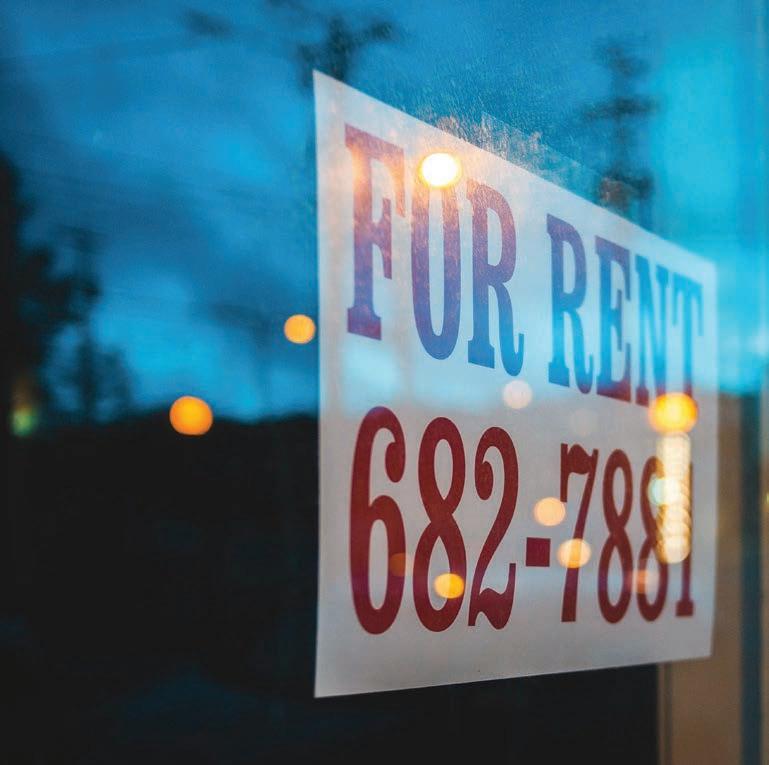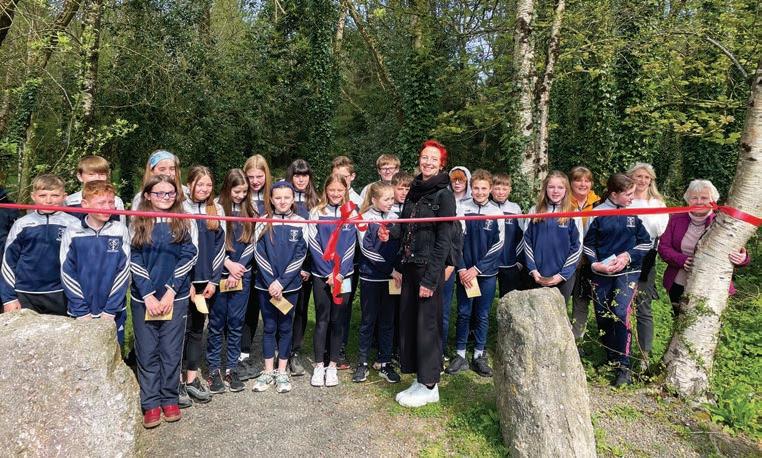
8 minute read
John Ellis
BY JOHN ELLIS
FINANCIAL ADVISOR
Advertisement

THE Residential Tenancies Board (RTB) report has been published. e RTB is a public body set up to support and develop “a wellfunctioning rental housing sector”. ey oversee the private rental market, the Approved Housing Body and accommodation speci c to students eir role is to regulate the rental sector, inform policy through the provision of information and research. ey also maintain the national register of tenancies. ey resolve disputes between tenants and landlords. ey investigate improper conduct by a landlord. For example, they will investigate and, if required, sanction a landlord for increasing rent by more than is allowed under the calculation set out in the Residential Tenancies Act. ey can sanction a landlord with a formal written caution and/ or ne up to €15,000 with costs up to the same amount.
According to their latest report: “ e general picture of the rental market for new tenancies for Q4 2021 can be characterised by a continued, and marked fall in the number of registered tenancies, and by an escalation in in ationary pressures on an annualised basis but with a slight moderation in the pace of within-year acceleration i.e. the quarter-on-quarter growth rate is negative.” e main ndings are as follows:
* New registered tenancies have fallen by 48% year on year to just under 9,350 new tenancies. * Rents on an annualised basis grew by 9% in Q4 of 2021.
* e national standardised average rent was €1,415 in Q4 2021, a decrease of €4 compared to the previous quarter. * Averaged standardised rents in Dublin stand at €1,972 while outside Dublin its €1,393. e di erence between rents in Dublin and outside Dublin are stark! A one bedroom house in Dublin on average is €1,500 a month whereas a four bedroom house outside Dublin is €1,266 a month.
In Kilkenny the standardised average rents in new tenancies is above €1,000 a month whereas in Leitrim the average is €740 a month. In Kilkenny according to the report the average standardised rent increased by 1.2% quarter on quarter while the averaged rent in new tenancies increased by 8.3% year on year.
Commenting on the report, reshold, the national housing charity, believes that the average yearly rental increase of 9% in new tenancies – as reported hides some of the incredibly worrying increases on a county and city level, particularly those subject to Rent Pressure Zones and a 2% cap on rent increases. reshold Chief Executive John-Mark McCa erty said: “ e average annual increase was 13.8% in Limerick City and 27.6% in Waterford City, which equate to an additional €1,844 and €2,740 in rent a year …with the spike in in ation and the huge increases in the cost of energy and fuel this is money that many people do not have to spare.” reshold have identi ed that private renters have become more accepting of invalid rent increases, as there are no other housing options available to them.
According to Mr McCa ery, 60% of rent review notices brought to reshold in the rst quarter of 2022 were invalid with more threshold’s clients seeking support with rent arrears as private renters simply cannot a ord their rent. ey are speaking to more and more stressed and anxious people seeking nancial assistance to make payments, or who are cutting back on essential items to stay in their homes. reshold believe there are ways to help theses distressed renters. ey propose the creation of a rent arrears fund to support renters. Increase the HAP limits to re ect current market rents. Changes the tax system to retain small landlords in the sector and so maintain supply as many small landlords are eeing the market. e 2% cap on rent increases mentioned in the report should be limiting rent increase, but the report suggests this is not the case.
You can contact reshold on 1800 454454 or go to the website www.threshold.ie regardless of where you live; in a Rent Pressure Zone or not and they will review your case. eir service is free, independent and con dential.
What latest report of rents crisis is saying
Launch of ‘A Way With Words’ Poetry Trail in Windgap

WINDGAP’S rst Poetry Trail and poetry booklet ‘A Way With Words’, funded through the Kilkenny County Council Arts O ce and Poetry Ireland’s Writers-in-Residence programme, was launched in the south Kilkenny village on April 28th (Poetry Day Ireland). e launch was the culmination of a writer-inresidence programme with author Debbie omas. In eight workshops, four for children and four for adults, participants from the Windgap area explored the theme of ‘Regeneration’. Fifth and sixth class pupils from Scoil San Nioclás, and older community members, re ected on family, home, the natural world and the ow and circle of life in Windgap. Debbie stated that the resulting poems ‘feel like a magni cent tree, celebrating the roots and branches, owers and fruit of this wonderful community’ and that she hopes that this project ‘sows the seed for more great writing from the wordsmiths of Windgap’.
Speaking at the launch, Kilkenny County Council Arts O cer Mary Butler spoke about how the project had enhanced the sense of place across the community and how this expands the emotive bonds and attachments of a community to its environment. She stated that it had been ‘a real joy to read the poetry developed during this project’ and of how poetry ‘provides us with new ways of thinking about ourselves, our surroundings and our life experiences’. e poems are now on display across the beautiful Windgap Village Loop Walk and the poetry trail will remain in place throughout the summer. Trail maps and postcard poems are available from the Lakeside Tea Rooms and all are invited to come along and enjoy ‘A Way With Words’.
e RTB report can be accessed at www.rtb.ie


john@ellis nancial.ie 086 8362633
Dear Editor
This year’s Darkness into Light event has a special resonance, I nd, coming as it does after the long months of lockdown and the recent weeks of living hell unleashed by a greedy dictator. And that’s without even mentioning the Climate Emergency, rising fuel costs, debt concerns, and the countless other slings and arrows that seem contrived to keep our hearts heavy and the smiles o our faces. ere are so many reasons to be downright miserable, depressed, and yes, suicidal... as we make this often rocky, sometimes hazardous, and occasionally frightening journey across time and space.
But I say it’s still worth staying the course. No matter how desperate or overwhelming the odds appear we mustn’t lose hope.
I found the early days of lockdown oppressive and almost unbearable. It was straight out of a dystopian novel about a futuristic society where life was just not worth living. Sometimes it felt like being under house arrest, or con ned to an open prison.
Except that life IS, I believe, worth living. A week or so into lockdown I found that walks in the countryside, even if restricted to two kilometres could be uplifting and therapeutic. Like many others, I rediscovered aspects of nature I’d forgotten about or blithely taken for granted.
Padraig Pearse in his poem e Wayfarer, eulogized about seeing a squirrel in a tree, butter ies, and rabbits playing in a sunlit meadow.
When I rst read the poem in primary school it meant nothing to me. I just wanted the class to end so I could get home. But lockdown recalled for me its emotional homage to nature. Breathing the clean country air during lockdown seemed a privilege. We couldn’t travel very far, or go to the pub, but we could reconnect with Mother Earth. So, lockdown had its upside, once you began to cope with it.
Some problems that people face are not so easily resolved, but equally we know that almost every problem, however scary or devastating it might appear, can be solved, or shared, or avoided...especially if we seek help with it. e reminder we hear so often from voluntary groups to “pick up the phone” is the best advice going, because it’s true that there’s always someone out there who can help turn things around.
A great case for avoiding suicide, I believe, is the fact that, according to research, almost every person who’s survived a suicidal attempt and had a Near Death Experience (NDE) was relieved that the attempt failed.
Some of them believed that a loved one on the “Other Side” had encouraged them to give life a chance. Whatever one’s religious belief or lack of it, I think it’s interesting that survivors of suicide invariably give the thumbs up to living, despite the often distressing or seemingly insoluble issues that led to the suicide attempt.
Sure, the world is full of horrors and dark clouds can obscure the minds and pathways of any human being, but there’s hope too; helping hands...support available by just reaching out.
It doesn’t have to be darkness for any of us, no matter how daunting the hand of cards that life has dealt us.
So, before contemplating or taking that nal step, why not talk to someone? ere’s light, too, in abundance, and relief, and rainbows in the sky, and solutions that maybe we hadn’t thought of.
Always... anking you,










